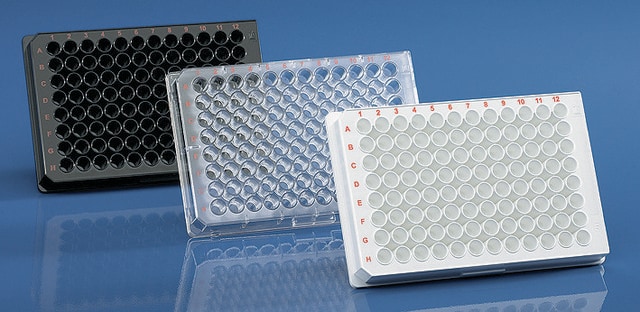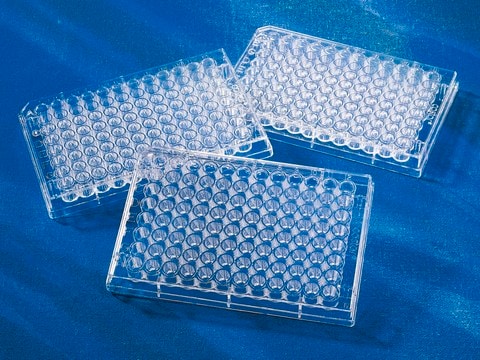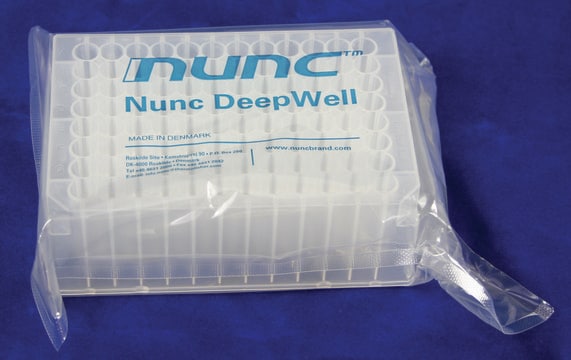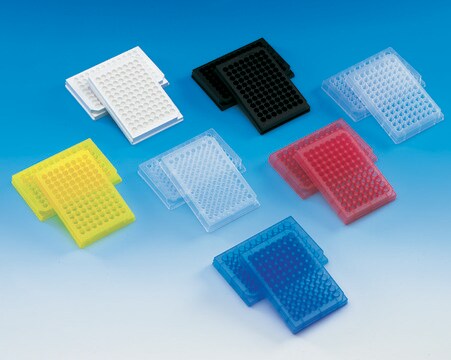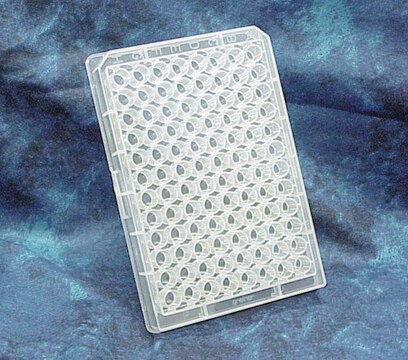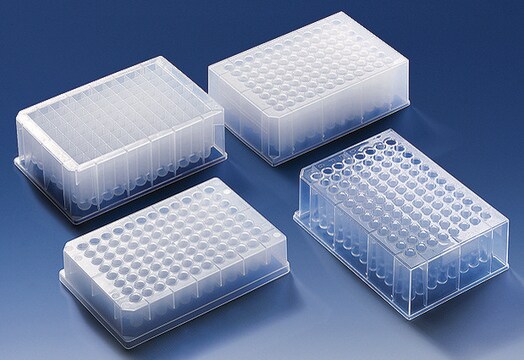BR701330
BRAND® 96-well microplate, U-bottom
round bottom, non-sterile
Synonym(s):
Microplates, Plates, Sample Storage
Sign Into View Organizational & Contract Pricing
All Photos(1)
About This Item
UNSPSC Code:
41121800
NACRES:
NB.15
Recommended Products
material
polypropylene
round bottom
sterility
non-sterile
packaging
pack of 100 ea
manufacturer/tradename
BRAND 701330
size
96 well
well maximum volume
300 μm
binding type
non-treated surface
General description
PP. For volumes up to 300 µl. Compatible with virtually all leading microplate centrifuges. Raised rings around the orifice of each well minimize possible cross-contamination. The plates can be sealed using self-adhesive films, such as DMSO-resistant sealing film (cross-cut) with alphanumeric coding.
Features and Benefits
- BRAND® 96-well microplate, U-bottom is a deep-well plate ideal for agglutination and other assays requiring stirring and washing of samples.
- Features a round-shaped well bottom with no edges.
- Raised rings around the orifice prevent possible cross-contamination.
- Compatible with a range of microplate centrifuges.
- Securely sealable with suitable sealing mats or self-adhesive sealing films.
- Alphanumeric code for accurate identification.
- Made from high-transparency medical grade polypropylene (PP) that facilitates sample visibility.
- Chemically resistant to most solvents including DMSO, phenol, and chloroform.
Legal Information
BRAND is a registered trademark of BRAND GMBH + CO KG
Choose from one of the most recent versions:
Certificates of Analysis (COA)
Lot/Batch Number
Sorry, we don't have COAs for this product available online at this time.
If you need assistance, please contact Customer Support.
Already Own This Product?
Find documentation for the products that you have recently purchased in the Document Library.
Customers Also Viewed
Stephen D Carter et al.
Science advances, 6(14), eaay9572-eaay9572 (2020-04-10)
The endoplasmic reticulum (ER) is a highly dynamic network of membranes. Here, we combine live-cell microscopy with in situ cryo-electron tomography to directly visualize ER dynamics in several secretory cell types including pancreatic β-cells and neurons under near-native conditions. Using
Gefei Chen et al.
Communications biology, 3(1), 32-32 (2020-01-22)
Molecular chaperones play important roles in preventing protein misfolding and its potentially harmful consequences. Deterioration of molecular chaperone systems upon ageing are thought to underlie age-related neurodegenerative diseases, and augmenting their activities could have therapeutic potential. The dementia relevant domain
SeongJun Han et al.
Oncoimmunology, 9(1), 1737368-1737368 (2020-04-22)
Regulatory T cells are integral to the regulation of autoimmune and anti-tumor immune responses. However, several studies have suggested that changes in T cell signaling networks can result in T cells that are resistant to the suppressive effects of regulatory
Rosalie Heilig et al.
Life science alliance, 3(6) (2020-04-30)
Caspase-1 drives a lytic inflammatory cell death named pyroptosis by cleaving the pore-forming cell death executor gasdermin-D (GSDMD). Gsdmd deficiency, however, only delays cell lysis, indicating that caspase-1 controls alternative cell death pathways. Here, we show that in the absence
Atsuya Nishiyama et al.
Nature communications, 11(1), 1222-1222 (2020-03-08)
Stable inheritance of DNA methylation is critical for maintaining differentiated phenotypes in multicellular organisms. We have recently identified dual mono-ubiquitylation of histone H3 (H3Ub2) by UHRF1 as an essential mechanism to recruit DNMT1 to chromatin. Here, we show that PCNA-associated
Our team of scientists has experience in all areas of research including Life Science, Material Science, Chemical Synthesis, Chromatography, Analytical and many others.
Contact Technical Service